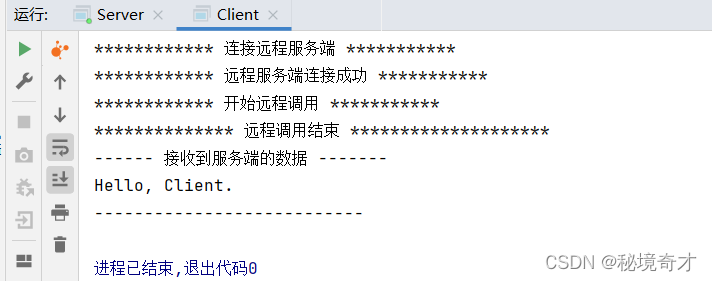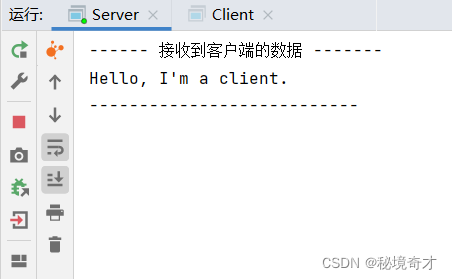??Java RMI 指 JDK 内置的关于实现远程方法调用(Remote Method Invocation)的 API。这些 API 位于包 java.rmi 中。通过 Java RMI,可以直接在客户端调用服务端的方法,并获得其返回值。Java RMI 是 RPC(Remote procedure call) 技术的 Java 实现,它提供了一种非常便捷的方式在 Java 中实现 RPC。
??使用 RMI 之前,需要知道以下概念:
-
服务端
-
服务端的暴露方法
-
客户端
??RMI 可以让客户端调用位于服务端的暴露方法(暴露方法的具体代码位于服务端),就像是这个暴露方法本来就位于客户端一样。不过要注意的是,虽然位于服务端的暴露方法是由客户端触发调用的,但暴露方法是在服务端运行的,客户端只能为其提供实参,并获得其返回值。
如何通信
??对于服务端,它需要为自己设置一个端口号,接着设置哪个对象对外暴露,并为每个暴露对象设置一个名称。暴露了这个对象,就相当于暴露了这个对象的 public 方法。然后,RMI 会自动为每个暴露对象生成一个唯一的 URL,URL 将根据服务端 IP、端口号、暴露对象名来生成。
??对于客户端,只需要根据这个暴露对象的 URL 就可以直接获得这个对象,然后就可以调用这个对象的 public 方法了。
实战
-
编写一个暴露对象接口,这个接口必须继承接口 Remote,而后者是 RMI 提供的接口。因为虽然客户端只需要根据 URL 就可以获得暴露对象,但 Java 的语法要求至少要有一个类型才能接收这个对象。也就是说,所有的暴露对象都必须是一个暴露对象接口的子类,且这个暴露对象接口必须对服务端、客户端都可见。
因此这个暴露对象接口将提供一系列供客户端远程调用的暴露方法。
package org.wangpai.demo.rmi.common; import java.rmi.Remote; import java.rmi.RemoteException; public interface Expose extends Remote { Response call(Request request) throws RemoteException; } -
编写提供给这个暴露方法的实参、返回值。注意:它们必须实现接口 Serializable,因为通信时,RMI 底层借助了对象的序列化、反序列化。
package org.wangpai.demo.rmi.common; import java.io.Serializable; public interface Request extends Serializable { Object getData(); }package org.wangpai.demo.rmi.common; import java.io.Serializable; public interface Response extends Serializable { Object getData(); } -
对于服务端的具体暴露对象所属的类,它必须还要将类 UnicastRemoteObject 继承,同时实现上面的暴露对象接口。对于服务端的这个具体暴露类,不必对客户端可见,因此服务端可以对其自由拓展。
package org.wangpai.demo.rmi.server; import java.rmi.RemoteException; import java.rmi.server.UnicastRemoteObject; import org.wangpai.demo.rmi.common.Expose; import org.wangpai.demo.rmi.common.Request; import org.wangpai.demo.rmi.common.Response; public class Service extends UnicastRemoteObject implements Expose { protected Service() throws RemoteException { super(); } @Override public Response call(Request request) throws RemoteException { System.out.println("------ 接收到客户端的数据 -------"); System.out.println(request.getData()); System.out.println("---------------------------"); return () -> "Hello, Client."; } } -
在服务端创建这个暴露类的对象,并注册在 RMI 中。
package org.wangpai.demo.rmi.server; import java.rmi.AlreadyBoundException; import java.rmi.RemoteException; import java.rmi.registry.LocateRegistry; import org.wangpai.demo.rmi.common.Protocol; public class Server { public static void start() throws RemoteException, AlreadyBoundException { var registry = LocateRegistry.createRegistry(Protocol.SERVER_PORT); var service = new Service(); registry.bind(Protocol.SERVICE_URL, service); } public static void main(String[] args) throws RemoteException, AlreadyBoundException { start(); } }这里,服务端需要与客户端进行一些约定,如服务端端口号、暴露对象的 URL 等。
package org.wangpai.demo.rmi.common; public class Protocol { public final static int SERVER_PORT = 7777; public final static String SERVER_BASE_URL = "rmi://127.0.0.1:" + SERVER_PORT + "/"; public final static String SERVICE_URL = "service"; } -
现在可以尝试在客户端进行远程调用了。
package org.wangpai.demo.rmi.client; import java.net.MalformedURLException; import java.rmi.Naming; import java.rmi.NotBoundException; import java.rmi.RemoteException; import org.wangpai.demo.rmi.common.Expose; import org.wangpai.demo.rmi.common.Protocol; import org.wangpai.demo.rmi.common.Request; public class Client { public static void remoteCall() throws MalformedURLException, NotBoundException, RemoteException { System.out.println("************ 连接远程服务端 ***********"); // 此处强制转换时,不能转换成类 Service var service = (Expose) Naming.lookup(Protocol.SERVER_BASE_URL + Protocol.SERVICE_URL); System.out.println("************ 远程服务端连接成功 ***********"); System.out.println("************ 开始远程调用 ***********"); var response = service.call((Request) () -> "Hello, I'm a client."); System.out.println("************** 远程调用结束 ********************"); System.out.println("------ 接收到服务端的数据 -------"); System.out.println(response.getData()); System.out.println("---------------------------"); } public static void main(String[] args) throws MalformedURLException, NotBoundException, RemoteException { remoteCall(); } } -
注意:项目运行的时候肯定是服务端先启动,然后客户端才能运行。
-
客户端运行效果图:

-
服务端运行效果图:

完整代码
??已上传至 GitCode 中,可免费下载:https://gitcode.net/wangpaiblog/20220202-java_rmi